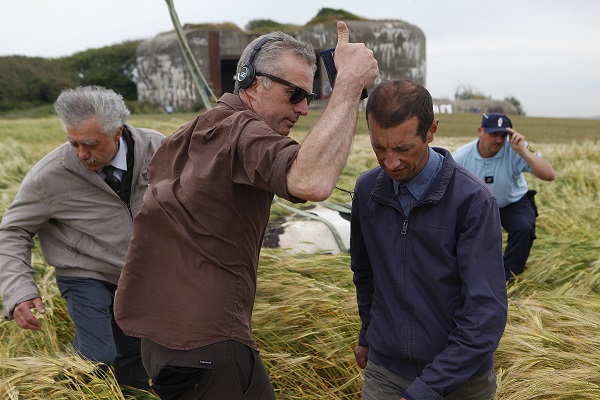French Film’s Master Magician Bruno Dumont Turns Tragedy Inside Out

Making of Li’l Quinquin with film director Bruno Dumont (center). Photo Credit: Kino Lorber.
Bruno Dumont is a trickster of the highest order. Don’t get me wrong — this French master of the cinematic art is also a very serious filmmaker. For the record, he’s an acclaimed auteur who has not only twice won the Cannes Festival’s Grand Prize and its Caméra d’Or (ie. Life of Jesus, Humanity, Flanders, Camille Claudel 1915), but has with the 52nd New York Film Festival’s special event Li’l Quinquin turned tragedy on its head for the first time. And that’s where the trickster part comes in. With a wave of his magic wand, he has produced a mini-series that almost defies description. It’s a supreme farce for starters, wrapped up in the guise of a murder mystery and delivering some of the most tender and tragic moments ever seen on screen. In its current festival format, it is meant to be viewed as a four-chapter series in one sitting.
Dumont’s Humanity won the Grand Prix in 1999, a more serious forerunner of this current exploration of murder and mayhem. In the present version, you have a Clouseau-like detective, played to perfection by Bernard Pruvost, and a petite prankster (the scruffy title character) caught up in a murderous web of intrigue that begins with the unlikely discovery of human body parts stuffed in — what else? — a village cow. Stir in a burgeoning love affair between little Quinquin and a local girl-child, seasoned with a repertory of characters — toothless, demented, or just plain addle-brained — and you have an absurdist cinematic stew that should appeal to the most discerning of palates.
Shortly before the film’s premiere, I sat down with Dumont at Kino Lorber’s distribution office in mid-Manhattan to discover the mind behind such outrageous and profound concoctions. In his mid-50s, he still retains a slim, youthful demeanor, topped off with a tousled head of gray hair. There’s an almost modest, quiet intensity about him, seemingly to belie the numerous accolades he has garnered in his career. We were assisted in our interview by a friendly and patient translator, who helped to keep the conversational ball rolling through both spaces of reflection and rapid-fire responses.
GALO: First off, I have to say I enjoyed the film immensely. I was particularly taken by the strange mix of comedy and tragedy together. That’s not easy to do and to get the desired response from your audience. You have said that comedy has the power to go to the heart of things. Earlier films of yours have struck a more serious tone. What was the genesis of Li’l Quinquin? An earlier novel, I think?
Bruno Dumont: Oh yes, first and foremost a novel. I always write novels to go deep into the drama and serious themes. When you reach the deep roots of drama, you can also find some comedy in it. I’m reinforcing my work, not changing it.
GALO: One of the first things that struck me, when you have a more serious theme — for instance, in live theatre — someone in the audience may start laughing almost uncontrollably at a tragic moment. And that’s tough sometimes for a performer to understand.
BD: Oui…
GALO: What has impressed you in film? In the U.S., we have the Coen Brothers with their film Fargo and Quentin Tarantino with that element of comedy and horror in all of his work. Who are the directors you know who have combined this mix?
BD: In France, there are very few directors who mix the two genres; the two different styles of comedy and drama. In the States, you can find more. But in Europe, they are different categories that don’t mix — for instance, Ingmar Bergman. He never made a comedy in his entire career…[At this time, Dumont reflects on a specific moment]. The only one I know is Jean Epstein — and he mixed the two genres. (Epstein was an impressionistic filmmaker from the 1920s and 1930s who also made a series of documentaries about Brittany.)
GALO: Finding the actors who can strike the right tone, possessing the right temperament, is not easy.
BD: Oh, no.
GALO: In Bernard Pruvost’s case, as the police chief, there’s this vulnerability, something childlike and Chaplin-esque. Even in the most horrible circumstances, he has these childish reactions. Conversely, with the amazing young actor Alane Delhaye, he seemed like a little old man…wise beyond his years. So how did you decide on them?
BD: To answer what you are saying, [I wanted] to reverse the natural way of things, to create a very stable, very full of love being such as Li’l Quinquin. It’s a very serious character. The police chief is like a clown. So I made a conscientious decision with the casting. All the decisions are made in the casting, so the boy in life is pretty close to his film character, but Bernard the chief, is very, very different from who he is in life. And that’s why he’s so funny.
GALO: He’s so farcical, the little tics, the things he does with his face…
[Laughter all around]
BD: Somehow he does act like a clown, naturally, for the film.
GALO: But to get the little boy and the little girl Eve — to get that laidback relationship between the kids is not easy. When you were directing, in both the dialogue and the interaction, did you allow for a certain improvisation?
BD: Whatever is natural is very boring to me. I’m bored with the boy-girl relationship, so I was trying to direct him like they were having a love affair like two adults. It was very difficult for them to touch each other, to say “my love.”
